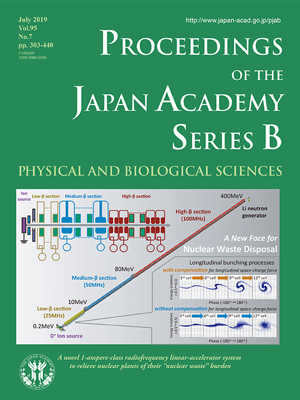About the Cover
Vol. 95 No. 7 (2019)
The disposal of long-lived radioactive fission products (LLFPs) in nuclear waste is a serious social issue to be technologically addressed. So far, a fast breeder reactor has been considered the most efficient facility to transmute LLFPs into manageable isotopes. On the other hand, recently, nuclear reactions on any radioactive isotopes including LLFPs have become possible for experimental studies, revealing that neutrons much faster than those generated inside breeder reactors are more efficient to transmute LLFPs. In the scheme illustrated on the cover page, sufficiently fast neutrons are generated through deuterons accelerated up to 400 MeV bombarding a thick lithium target. The 400 MeV deuterons are produced by a superconducting radiofrequency linear accelerator (linac). The uniqueness of the linac is: the deuteron beam current is unconventionally as huge as 1 ampere, which is required to generate a neutron flux high enough to practically transmute LLFPs wasted from nuclear plants. The 1 ampere linac is the first proposal in the world. The novelty of the linac is its large bore, e.g. 15 cm in diameter in the low-β (velocity) section, resulting in reducing the current density to mitigate the Coulomb repulsive force due to the enormous transversal and longitudinal space-charge to blow up the beam size. The invention by Okuno et al. (pp. 430-439) is to realize such a large bore throughout the linac by stacking single-cell linacs, each of which has a large-bore magnetic transversal focusing element to compensate for the transversal space-charge force, and implement a function to fully tune the phase and voltage of radiofrequency (rf) cell-by-cell to compensate any longitudinal force. The conceptual structure is depicted in the top-left inset. A realistic beam-dynamics simulation has been conducted; e.g. shown in the bottom-right inset, illustrated the longitudinal bunching processes of direct-current particles from the 1 ampere ion source in the low-β entrance section (e.g. 3rd-12th cell). Through fine tuning the rf phase and voltage in each cell, the bunching effect is improved from “without compensation” bunching to “with compensation” bunching. In the case of “without compensation”, a number of the particles are not well bunched inside the acceptable phase width, resulting in a harmful halo beam in the acceleration section. This tuning can be done only by employing the single-cell configuration. In the summary of this paper, concerning the feasibility of industrial applications, Okuno et al. estimate that the electric power consumed to transmute LLFPs waste from a nuclear plant is well below the electric power generated by a nuclear plant.
Yasushige Yano
Senior advisor of RIKEN Nishina Center for Accelerator-based Science




